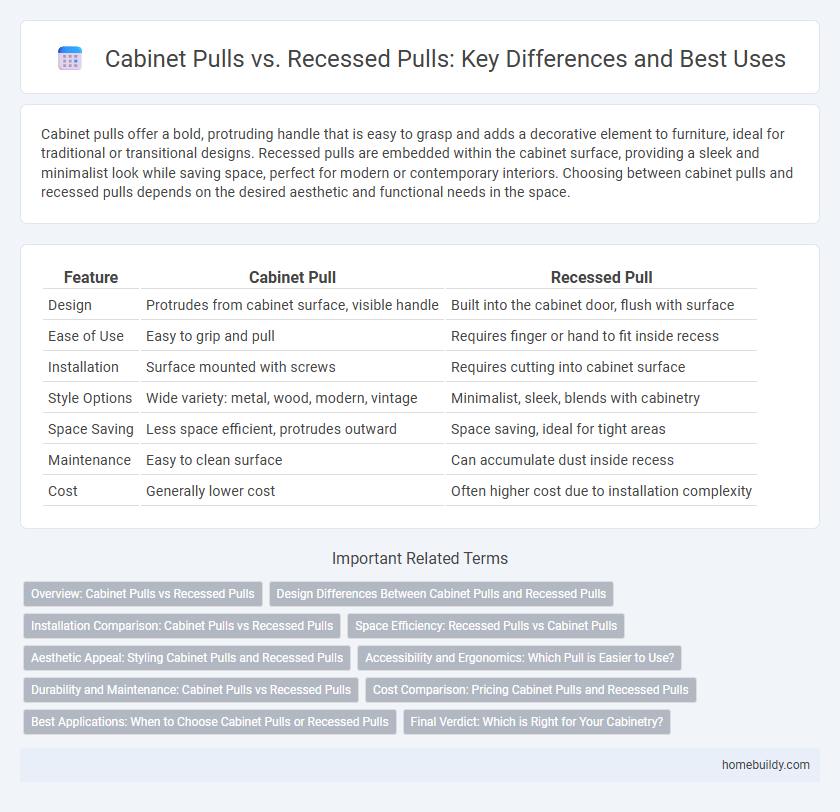Cabinet pulls offer a bold, protruding handle that is easy to grasp and adds a decorative element to furniture, ideal for traditional or transitional designs. Recessed pulls are embedded within the cabinet surface, providing a sleek and minimalist look while saving space, perfect for modern or contemporary interiors. Choosing between cabinet pulls and recessed pulls depends on the desired aesthetic and functional needs in the space.
Table of Comparison
| Feature | Cabinet Pull | Recessed Pull |
|---|---|---|
| Design | Protrudes from cabinet surface, visible handle | Built into the cabinet door, flush with surface |
| Ease of Use | Easy to grip and pull | Requires finger or hand to fit inside recess |
| Installation | Surface mounted with screws | Requires cutting into cabinet surface |
| Style Options | Wide variety: metal, wood, modern, vintage | Minimalist, sleek, blends with cabinetry |
| Space Saving | Less space efficient, protrudes outward | Space saving, ideal for tight areas |
| Maintenance | Easy to clean surface | Can accumulate dust inside recess |
| Cost | Generally lower cost | Often higher cost due to installation complexity |
Overview: Cabinet Pulls vs Recessed Pulls
Cabinet pulls offer a traditional, protruding handle design that provides easy grip and adds decorative appeal to cabinetry, making them ideal for enhancing style and accessibility. Recessed pulls are embedded into the cabinet surface, offering a sleek, minimalist look while saving space in tight areas, often preferred in modern or compact kitchen designs. Choosing between cabinet pulls and recessed pulls depends on desired aesthetics, ergonomic preferences, and spatial considerations for functional cabinetry hardware.
Design Differences Between Cabinet Pulls and Recessed Pulls
Cabinet pulls typically protrude from the surface, offering a three-dimensional design that enhances grip and adds decorative detail to cabinetry. Recessed pulls are embedded within the cabinet face, providing a sleek, flush finish ideal for minimalist or modern interiors. The choice between cabinet pulls and recessed pulls depends on aesthetic preferences and functional considerations, such as ease of use and space constraints.
Installation Comparison: Cabinet Pulls vs Recessed Pulls
Cabinet pulls require surface mounting with screws, making installation straightforward and suitable for DIY projects, while recessed pulls need precise cutouts in the cabinet door or drawer, often demanding professional tools and skills. Recessed pulls offer a flush finish that enhances sleek cabinetry design but complicate alignment and depth measurements during installation. Cabinet pulls provide easier replacement or adjustment due to their external mounting, contrasting with recessed pulls that require careful modification to avoid damage to the cabinetry.
Space Efficiency: Recessed Pulls vs Cabinet Pulls
Recessed pulls provide superior space efficiency compared to traditional cabinet pulls by sitting flush within the cabinet door, eliminating protrusions that can interfere with tight spaces. This design is ideal for compact kitchens or areas where clearance is limited, enhancing both functionality and safety. While cabinet pulls add a decorative element, recessed pulls maximize available space and streamline the overall aesthetic.
Aesthetic Appeal: Styling Cabinet Pulls and Recessed Pulls
Cabinet pulls enhance the aesthetic appeal by showcasing a bold, traditional look that stands out on cabinet fronts, adding a decorative element to the overall design. Recessed pulls provide a sleek, minimalist style by sitting flush with the cabinet surface, creating a streamlined and modern appearance. Choosing between cabinet pulls and recessed pulls depends on whether the design goal prioritizes visual prominence or subtle elegance in kitchen or furniture styling.
Accessibility and Ergonomics: Which Pull is Easier to Use?
Cabinet pulls offer superior accessibility due to their protruding handles, allowing for a firm and comfortable grip that accommodates various hand sizes and dexterity levels. Recessed pulls, while sleek and space-saving, require more precise finger placement, potentially making them less ergonomic for individuals with limited hand strength or mobility issues. Ergonomically, cabinet pulls reduce strain by providing a natural pulling motion, enhancing ease of use in everyday tasks.
Durability and Maintenance: Cabinet Pulls vs Recessed Pulls
Cabinet pulls generally offer greater durability due to their solid construction and easier accessibility, reducing wear from frequent use. Recessed pulls, while sleek in design, can accumulate dust and grime within grooves, requiring more frequent maintenance and careful cleaning. The exposed nature of cabinet pulls allows for simpler repairs or replacements, enhancing their longevity compared to recessed pulls.
Cost Comparison: Pricing Cabinet Pulls and Recessed Pulls
Cabinet pulls generally cost between $5 and $25 each depending on material and design, while recessed pulls tend to be priced higher, averaging $15 to $40 due to their more complex installation and integrated design. Installation expenses for recessed pulls can increase the overall cost significantly, as they require precise routing and professional labor compared to the straightforward mounting of standard cabinet pulls. Budget-conscious homeowners often select cabinet pulls for affordability and ease of replacement, whereas recessed pulls are preferred for sleek aesthetics despite the higher price point.
Best Applications: When to Choose Cabinet Pulls or Recessed Pulls
Cabinet pulls are best suited for traditional or transitional kitchen designs where their protruding handles provide easy grip and enhance accessibility, making them ideal for larger drawers and doors frequently used. Recessed pulls are preferable in modern or minimalist spaces where a sleek, flush appearance is desired, especially on flat cabinet fronts or tight spaces that require a streamlined look without protruding hardware. Choosing between cabinet pulls and recessed pulls depends on balancing functionality, aesthetic preference, and space constraints in kitchen or bathroom cabinetry.
Final Verdict: Which is Right for Your Cabinetry?
Cabinet pulls offer a bold, traditional grip that complements classic or farmhouse cabinetry styles, while recessed pulls provide a sleek, modern look ideal for minimalist and contemporary designs. Choosing between cabinet pulls and recessed pulls depends on your aesthetic preference, cabinet door thickness, and ease of use, as recessed pulls require precise installation and thinner doors. For durability and ergonomic grip, cabinet pulls are preferred; for space-saving and streamlined appearance, recessed pulls excel.
cabinet pull vs recessed pull Infographic

 homebuildy.com
homebuildy.com